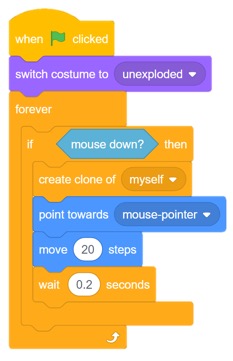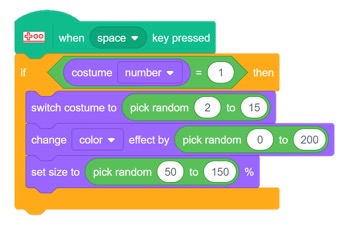Levels 3-8
NGV Digital Creatives programs support the integration of STEM (science, technology, engineering and maths) and the visual arts and provide an authentic context for developing problem solving, critical and creative thinking skills.
As part of NGV Digital Creatives, a new coding workshop is developed alongside each major exhibition. Workshops are held in the NGV’s Learning studios and gallery spaces, making use of digital tools including Scratch – a block-based visual programming language designed by the MIT Media Lab that teaches students the foundations of coding – and MaKey MaKey – an electronic invention kit used to familiarise students with the basic components of a circuit. Combining mathematical and computational thinking with playful ingenuity, we apply coding creatively to make new things.
Exploding Coding
Cai Guo-Qiang is a contemporary Chinese artist who uses fireworks and gunpowder to create works of art. To create his gunpowder paintings, Cai ‘draws’ with gunpowder on paper, silk or other surfaces and then ignites the gunpowder to make marks. The results are a surprising mixture of design and chance.
In parallel with the exhibition Terracotta Warriors: Guardians of Immortality (24 May-13 Oct 19) Cai Guo-Qiang was invited to create a display of new work to be presented alongside the terracotta warriors and other treasures of historic Chinese art and design. His work is exhibited under the tile Cai Guo-Qiang: The Transient Landscape. Inspired by Cai’s gunpowder paintings, this NGV Digital Creatives Exploding Coding workshop uses code for creative mark making. This resource includes a brief introduction to the work of artist Cai Guo-Qiang and workshop instructions.
Supported by Telstra

Teachers Notes
-
ABOUT CAI GUO-QIANG
Cai Guo-Qiang’s work crosses multiple mediums including drawing, installation, video, and performance, but he is best known for his use of fireworks and gunpowder. Cai’s projects include the design of the fireworks displays at the opening and closing ceremonies of the 2008 Beijing Olympic Games and Sky Ladder, 2015, a project in which a 500 metre long ladder covered with fuses and fireworks, held up by a giant helium balloon, was ignited at dawn over the harbour in Cai’s home town of Quanzhou.
Cai Guo-Qiang, known by his family name Cai, was born in Quanzhou, China, in 1957. In his late teens and early twenties Cai acted in two martial arts films The Spring and Fall of a Small Town and Real Kung Fu of Shaolin, before training in stage design at the Shanghai Theatre Academy from 1981 to 1985. Cai began to explore the use of gunpowder in his art in the 1980s, mixing oil paint with gunpowder directly onto canvas and setting it alight as a way to introduce the unpredictable forces of nature.
Although gunpowder might seem like an unusual medium for art making, it is deeply connected to Chinese culture. Gunpowder, one of ancient China’s four great inventions, was discovered by monks in the ninth century. Saltpetre (potassium nitrate), one of the ingredients in gunpowder, was used by the ancient Chinese for medicinal purposes. The monks, looking for an elixir to prolong life, discovered that the right combination of saltpetre, charcoal and sulphur would burn rapidly and explode with a flash and a bang. The Chinese term for gunpowder translates as fire medicine. Firecrackers and fireworks have played a part in Chinese festivities and celebrations since the time of their invention, traditionally to scare away evil spirits and to bring luck. China is still the world’s biggest producer and exporter of fireworks.
From 1986 to 1995, Cai lived in Japan, developing his use of gunpowder further with large-scale gunpowder works and explosion events. Since 1995, Cai has lived and worked in New York. His exhibitions and projects have crossed the globe and encompassed various forms and themes.
Learn more about Cai’s life and projects, visit the artist’s web page
CAI GUO-QIANG: THE TRANSIENT LANDSCAPE
The works that Cai has created for Cai Guo-Qiang: Transient Landscape use traditional Chinese materials like paper, porcelain, silk and gunpowder, and are inspired by Chinese history and culture from the time of the reign of China’s first emperor Qin Shihuang and the creation of the terracotta warriors. Cai’s works encourage the viewer to reflect on time, place and history, making links between the present and the past.
The Transient Landscape includes three large-scale gunpowder paintings: Transience II (Peony) 2019, on silk, and Flow (Cypress) 2019 and Pulse (Mountain) 2019, on paper.
The gunpowder paintings resemble traditional Chinese shui mo (water and ink) paintings, but on a much larger scale.
Pulse (Mountain) represents the vast mountains and horizons of China’s Central Plains, where many developments of Chinese civilisation took place.
Flow (Cypress) is inspired by the cypress forest said to have surrounded the tomb of the legendary Yellow Emperor (Huangdi). In Chinese art and literature the cypress symbolises longevity, resilience, and moral integrity.
The peony flower, depicted in Transience II (Peony) symbolises royalty, virtue and honour. Peony blossoms last only for a short time. Cai’s drawing shows the flower blooming and then wilting away.To create his gunpowder paintings, Cai places sheets of paper or silk on the floor. On these, he places fuses and loose gunpowder according to his prior design.
Sometimes stencils are placed to emphasise certain shapes or areas. These are covered with boards that are then weighed down with rocks to hold the elements in place.
The fuses are ignited at one end and the gunpowder explodes across the work. Once the sparks are extinguished, the boards and stencils are removed leaving the finished work.
Cai talks about his use of gunpowder as a way to reveal the invisible:
One very important concept and pursuit in my art is using visible means to illustrate invisible worlds. The fleeting moment of the explosion transmits the energy hidden in the everyday objects that we see. In the instant of the explosion, we may sense the real meaning of time and space; it connects us with invisible energy and even makes us feel we’re connected with the eternity of the universe.
(Interview with Cai Guo-Qiang, NGV Magazine, Issue 16 May-Jun 2019 p 43)
EXPLODING CODING
Aim
This workshop aims to encourage critical and creative thinking by engaging students in art making with non-traditional tools. Students are introduced to:- key programming concepts including sequencing, repetition, variables and if/else statements
- input devices, electric circuits and switches
- creating and making with Scratch and MaKey MaKey
Outcome
Students create their own ‘gunpowder’ painting and ignition device. They customise their work by making alterations to the code and costumes within the program as well as to their own input device.WORKSHOP INSTRUCTIONS
Step 1
Open the Exploding Coding project in Scratch
Inspired by Cai Guo-Qiang’s gunpowder paintings, this program lets us create a drawing with ‘gunpowder’ and then explode it to create a new work of art. To run the program, click on the green flag. Use your mouse to draw with the gunpowder. Use your space bar to ‘ignite’ your drawing. Your drawing will explode into colour.


Step 2
Let’s have a look inside the program to see how it works.

The completed script looks like this:


Look inside the Costumes tab:
Notice the different costumes. There is one costume for unexploded gunpowder, and fourteen different costumes for exploded gunpowder.
Setting up:

These blocks start the program and make sure the unexploded gunpowder appears instead of anything else.
The next blocks let us use the mouse to draw. If the mouse is down, then a clone of the unexploded costume is dropped near the mouse pointer.

The following blocks control the spread of gunpowder and the rate that the gunpowder is dropped.

The forever block tells the program to keep following the instructions contained within it forever – while the program is running.

The blocks below describe what will happen when the space bar is pressed.

Ignition:
This block starts the ignition.

The blocks below find all the unexploded gunpowder (costume 1) and switch the unexploded gunpowder to a random exploded costume (exploded 2-15), a random colour effect and a random size.

Step 3
MaKey MaKey
Instead of using the space bar on the key board as a controller, we can connect an external input device to our program using MaKey MaKey.
MaKey MaKey is a two-sided circuit board. On the more simple, top side, the MaKey MaKey has 6-inputs: the up/down/left/right arrow keys, as well as the space bar and mouse left click.
Each of those inputs is in the form of a pair of holes that allows alligator clip cables to be clipped in. The holes along the bottom of the circuit board are the Earth holes.
Circuits, conductors, insulators
Electricity needs an unbroken, continuous path for the current to flow. It will usually take the path of least resistance. Materials that allow electricity to flow are called conductors. Many materials are conductors, including metals, water and humans. Materials that don’t conduct electricity are called non-conductors or insulators.
MaKey MaKey lets us experiment with using different conductive materials to complete a circuit and allow the current to flow.
Making an external ignition device
Design a device or ignition switch to start your explosion. You could draw your design, or make your design in 3D from conductive materials like foil or plasticine.
Step 4
Making the circuit
Plug the circuit board into the USB port of your computer. Clip an alligator clip to the space control holes and attach the other end of this clip to your ignition switch. Clip an alligator clip to the earth holes. Close the circuit by holding the alligator clip on the end of the earth wire and pressing the ignition switch at the same time. If your circuit is complete, your program should start when the ignition button is pressed. Some different examples of ignition switches are pictured here.
Step 5
Now that you have made an ignition device, you can experiment with customising your work. Try:
- adding sounds by going into the Sounds tab (You can choose from existing effects or record your own)
- changing the costumes in the Costumes tab
- adjusting the placement of the gunpowder and the rate of placement
